Researchers Know What People The Coronavirus Is More Likely To Kill
- A massive coronavirus Oxford study provides the same tips as previous work on the matter when it comes to the risk factors that can lead to COVID-19 complications and death.
- The study looked at records belonging to 17 million Britons, including more than ten thousand COVID-19 fatalities, and identified the same risk factors are previous work.
- Existing medical conditions, age, sex, and race are all factors that can increase the risk of death of coronavirus patients.
The novel coronavirus pandemic is here to stay for a much longer while than we may have hoped. It's not that we expected the virus to be eradicated anytime soon. That may never happen, and we'll have to learn to live with COVID-19. But the world's coronavirus curve is far from being flattened. In fact, the virus needed just five days to infect its twelfth million people, which is another record that COVID-19 broke. We can't even be sure whether we're nearing the peak of the pandemic globally. Some nations have quashed their outbreaks and are now fighting to contain smaller ones. But countries like America, Brazil, and India continue to report tens of thousands of daily cases.
As we've already explained, the world is much better positioned to deal with COVID-19 patients than in March. Therapies work, and severe cases aren't necessarily doomed to death. But the fatality rate remains high as there's no cure available that can prevent the disease or treat the massive complications. It's up to individuals to protect themselves as much as possible, by social distancing whenever they can, wearing face masks, and washing hands often. The virus can infect anyone regardless of age, social status, or access to high-quality medical care. And it can kill anyone, regardless of comorbidities. That's what makes it so dangerous. But researchers know exactly what kind of people SARS-CoV-2 is more likely to kill, and it's those people who should take all the precautions available to them to prevent infection.
Published in Nature, the study doesn't deliver any surprising conclusions. It's the same types of existing medical conditions, combined with age, sex, and race that make COVID-19 more dangerous for more people. But the Oxford study is the world's biggest such research.
The researchers looked at health data for 17 million people in England, which makes it the largest of its kind. The researchers looked at de-identified health records belonging to 40% of England's population. That's 17,278,392 adults tracked over three months. Of them, 10,926 died of COVID-19 and COVID-19 complications.
"A lot of previous work has focused on patients that present at hospital," Oxford's Dr. Ben Goldacre told MSN. "That's useful and important, but we wanted to get a clear sense of the risks as an everyday person. Our starting pool is literally everybody."
The researchers found that patients older than 80 were at least 20 times more likely to die from COVID-19 than those in their 50s. Or hundreds of times more likely to die than people under 40. That's a "jaw-dropping" difference, Goldacre said.
Men were more likely to die than women of the same age. Other conditions, including obesity, diabetes, severe asthma, and compromised immunity, were also linked to poor outcomes. Socioeconomic factors like poverty also increase a person's chance of dying of COVID-19.
The study also looked at the effects of race and ethnicity on COVID-19-related deaths. Roughly 11% of patients were identified as nonwhite, and the researchers found that black and South Asian people were at higher risk of dying than white patients. Even after the scientists made corrections to account for age, sex, and medical conditions, the trend persisted.
The researchers also removed variables like chronic heart disease to focus solely on the effects of race and ethnicity. The heart condition is a risk factor for COVID-19, but it's also more prevalent among black people. But black people are also more likely to experience stress and be denied medical service, so the disparity in heart disease may itself be influenced by racism. Some criticized this approach, as ignoring the heart disease risk could lead to wrong conclusions about the relationship between race and ethnicity and COVID-19 deaths.
Despite some criticism about methodology, the study still reaffirms the same concerns about at-risk patients observed from the early days of the pandemic. The scope of the study further serves to verify earlier conclusions. At the same time, we did see extensive studies that had to be retracted after it became clear that the dataset could not be audited by independent reviewers. That's not to say the Oxford study is in the same boat. But any COVID-19 research can definitely benefit from additional confirmations.
Johns Hopkins University epidemiologist Avonne Connor said of the study that the large data set "is astounding," saying that it adds "another layer to depicting who is at risk," even though the conclusions are in line with what has been observed so far.
Assessing the risk factors correctly for COVID-19 cases could help authorities come up with better public health policies for preventing infection and providing proper access to potential cures and vaccines once they're available.
